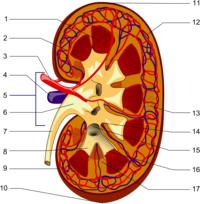
Photo from wikipedia
BackgroundRenal transplant is the preferred treatment option for these patients with end-stage renal disease. Transplant renal artery stenosis (TRAS) is one of the most common and serious vascular complications after… Click to show full abstract
BackgroundRenal transplant is the preferred treatment option for these patients with end-stage renal disease. Transplant renal artery stenosis (TRAS) is one of the most common and serious vascular complications after renal transplantation, and most of the TRAS occurred in the anastomosis. The complication must be diagnosed and treated timely, otherwise the function of transplanted kidney may be losed.Case presentationA 46-year-old male with end-stage renal disease of unknown cause received a cadaveric renal transplant one year ago. Although three antihypertensive medications were administrated, his blood pressure gradually increased to 190/120 mmHg 3 weeks posttransplantation. Also the level of creatinine increased to 194 μmol/L.Color Doppler ultrasonography indicated a decreased resistance index (RI) in intrarenal arteries and increased blood flow of the transplant renal artery, therefore, a vascular complication of TRAS was suspected. Arteriography was performed and demonstrated TRAS caused by stretch of an artery branch, and the TRAS occurred in the distal site of the anastomosis instead of the anastomosis. Percutaneous transluminal bare stent implantation treatment was successfully performed. Satisfactory clinical efficacy with improvement in transplant renal function and renovascular hypertension was achieved after the interventional treatment.ConclusionTo our knowledge this is the first reported case of TRAS caused by stretch of an artery branch. When refractory hypertension and allograft dysfunction are presented posttransplantation, TRAS should be suspected. Color Doppler ultrasonography as a non-invasive examination may provide some valuable information, three-dimention CT can be useful for further diagnosis, but is seldom necessary. Arteriography provides the definitive diagnosis of TRAS. Percutaneous transluminal stent implantation treatment of TRAS has high success rate with minimal invasion and complications. When an artery branch situated on the stenosis, a bare stent rather than covered stent is the preferred choice.
Journal Title: BMC Nephrology
Year Published: 2018
Link to full text (if available)
Share on Social Media: Sign Up to like & get
recommendations!